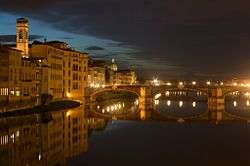Ponte Santa Trinita
|
Ponte Santa Trìnita. View from Ponte Vecchio. | |
| Material | Limestone |
|---|---|
| Created | Renaissance Period (1566-1569) by Bartolomeo Ammannati. |
| Present location | Florence, Italy |
The Ponte Santa Trìnita (Italian for Holy Trinity Bridge, named for the ancient church in the nearest stretch of via de' Tornabuoni) is a Renaissance bridge in Florence, Italy, spanning the Arno. The Ponte Santa Trìnita is the oldest elliptic arch bridge in the world, the three flattened ellipses giving the structure its celebrated elegant appearance. The outside spans each measure 29 m (95 ft) with the centre span being 32 m (105 ft) in length.[1] The two neighbouring bridges are the Ponte Vecchio, to the east, and the Ponte alla Carraia to the west.
The bridge was constructed by the Florentine architect Bartolomeo Ammannati from 1567 to 1569. Its site, downstream of the equally remarkable Ponte Vecchio,[2] is a major link in the medieval street plan of Florence, which has been bridged at this site since the thirteenth century.[3] The wooden bridge of 1252 was swept away in a flood seven years later and was rebuilt in stone and destroyed in a flood in 1333. The bridge of five arches constructed by Taddeo Gaddi was destroyed in the flood of 1557, which occasioned Ammannati's replacement. Four ornamental statues of the Seasons were added to the bridge in 1608, as part of the wedding celebrations of Cosimo II de' Medici with Maria Magdalena of Austria: Spring by Pietro Francavilla, Summer and Autumn by Giovanni Caccini, and Winter by Taddeo Landini.

On the night between 3 and 4 of August 1944, the bridge was destroyed by retreating German troops on the advance of the British 8th Army. A Bailey bridge was built for temporary use by the Royal engineers. The bridge was reconstructed in 1958 with original stones raised from the Arno[4] or taken from the same quarry, under the direction of architect Riccardo Gizdulich, and engineer Emilio Brizzi.[5] The missing head of Primavera was recovered from the bed of the Arno in October 1961.[6]
See also
Notes
- ↑ "Ponte Santa Trinita". Structurae. Retrieved February 16, 2007.
- ↑ Ammannati, Bartolommeo. Encyclopædia Britannica. 2007.
- ↑ Touring Club Italiano, Firenze e Dintorni (1922) 1964, p. 309.
- ↑ Bridges: Stone arch bridges. Encyclopædia Britannica. 2007.
- ↑ TCI Firenze e Dintorni, eo. loc.
- ↑ "Tramvia comes to Florence. Florence builds across the Arno for only the second time in four centuries". fssweb.berry.edu. Retrieved 19 December 2010.
External links
| Wikimedia Commons has media related to Ponte Santa Trinita. |
Coordinates: 43°46′08″N 11°15′01″E / 43.76889°N 11.25028°E
